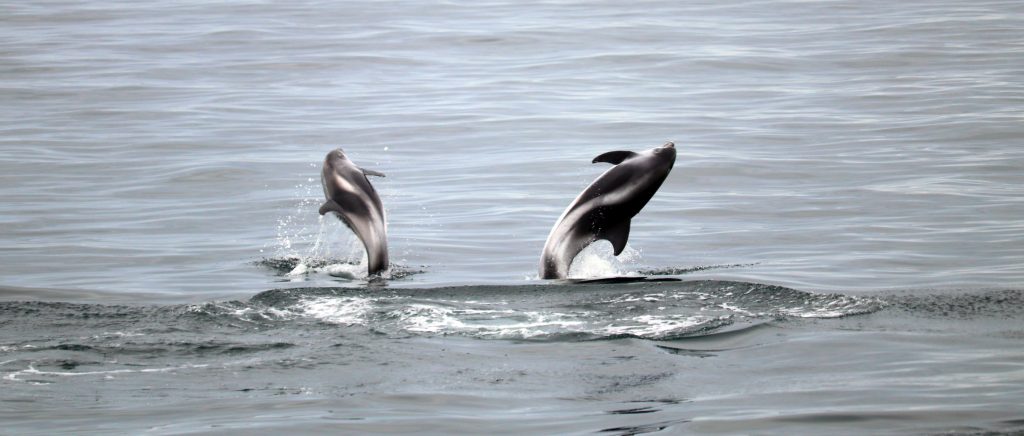This blog has been inspired by the flurry of activity our white-beaked dolphins have been showing recently. White-beaked dolphins are one of our most active species and have stolen the hearts of most of our guides by riding the bows of our boats and jumping magnificently around us.
For those of you who want more than simply to indulge in the beauty of their leaps and bounds, we thought we would put together a little fact file for you.
Firstly, you will need to know how to tell the difference between a white-beaked dolphin and any of their cousins. The best clue here will always be the waters they are found in. These dolphins are one of the only dolphin species worldwide who truly appreciate the cold. Never found below England or Ireland, these eclectic individuals prefer water temperatures of less than 12 degrees Celsius.
Aside from this, they are known to have a much more robust body than other dolphins and a much ‘snubbier’ snout. Of course, the beautiful grey and white markings all along their bodies make them most identifiable when you can get close enough to really study them- and we often do, as they are frequently seen riding the bows of our boats here in Iceland!
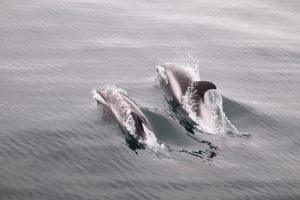
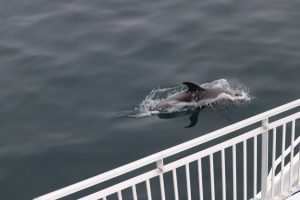
We must, embarrassingly, admit that we actually don’t know all that much about white-beaked dolphins. We know that they are found in Icelandic waters year-round, and not just in Faxafloi Bay. We have been studying them for over twenty-one years (longer than the lifetime of our company!) but we still do not have a full understanding of their range and behavioural traits.
One thing that we can do is create a catalogue of all our known sightings. Dolphin species worldwide can be identified using high quality photographs that focus on the dorsal fin of a given individual. If you look closely at the fin in the photo below, you can see a small nick along the back edge. This cut will set this particular dolphin apart from others of its species and enable us to create a profile for him or her in the University of Iceland’s catalogue. In cases where the nick is particularly similar to another individuals’ markings, we then refer to their natural marking patterns. For example, this individual has a remarkable white stripe along the side, which would make them stand out from others easily.
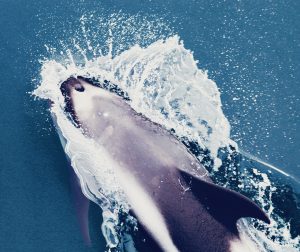
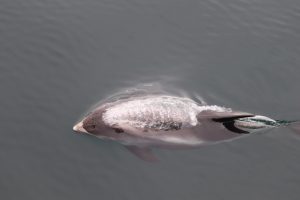
The natural markings of an individual do not only tell us their ‘ID’, but they provide us with a good insight into the life history of the species including movement and social structure. Natural markings in cetaceans can be a result of parasites, predator attacks, anthropogenic activities or congenital activities, to name but a few. Some marks are more common and consistent than others, and really indicate the kinds of lives these mammals lead. To give a larger scale example, in Icelandic waters minke whales are often spotted with injuries indicating the attack of a cookiecutter shark, while this is extremely rare in the white beaked dolphins. This is because minke whales dive much deeper than the white-beaked dolphins and can hold their breath for longer. As cookiecutter sharks are a demersal species who prefer to spend time between depths of 1-3.7km and migrate vertically to depths only as shallow as 85m to feed, they are much less likely to encounter the much shallower-dwelling dolphins, and therefore bites are more common in minke whales.
White-beaked dolphins are one of few species whose ‘blotches’ on their dorsal fins appear to be permanent (while with others, they can tend to fade with age). In this way, we can utilize their unique spot patterns repeatedly over the years to understand the residency of our populations. It seems that this residency is indeed high, with some individuals spotted consistently throughout Iceland.
As long as you know what to look for, the dolphins can be quite unique. On our tours you might occasionally be lucky enough to encounter a particularly well-known individual, and your guide may already know him or her by name. Alternatively, if you are fortunate enough to see a mother with her young calves, it could be that you are spotting an individual who has never before been documented – and for that reason, you should always keep your camera handy on a Special Tours adventure!
by: Catherine Cushenan (Guide)
